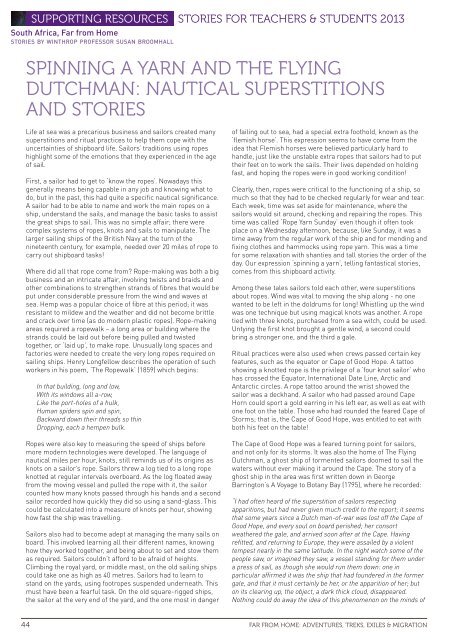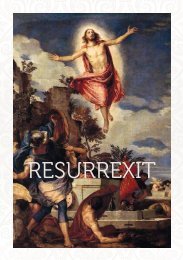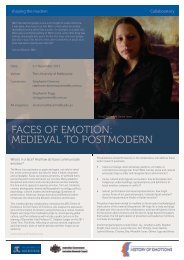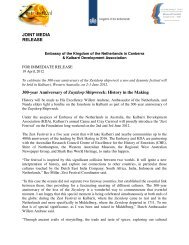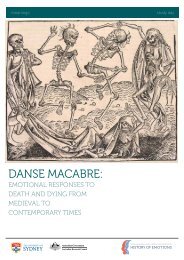Download our K-12 education pack - ARC Centre of Excellence for ...
Download our K-12 education pack - ARC Centre of Excellence for ...
Download our K-12 education pack - ARC Centre of Excellence for ...
You also want an ePaper? Increase the reach of your titles
YUMPU automatically turns print PDFs into web optimized ePapers that Google loves.
Supporting Res<strong>our</strong>ces stories <strong>for</strong> teachers & students 2013<br />
South Africa, Far from Home<br />
stories by winthrop pr<strong>of</strong>essor susan broomhall<br />
Spinning a yarn and the Flying<br />
Dutchman: nautical superstitions<br />
and stories<br />
Life at sea was a precarious business and sailors created many<br />
superstitions and ritual practices to help them cope with the<br />
uncertainties <strong>of</strong> shipboard life. Sailors’ traditions using ropes<br />
highlight some <strong>of</strong> the emotions that they experienced in the age<br />
<strong>of</strong> sail.<br />
First, a sailor had to get to ‘know the ropes’. Nowadays this<br />
generally means being capable in any job and knowing what to<br />
do, but in the past, this had quite a specific nautical significance.<br />
A sailor had to be able to name and work the main ropes on a<br />
ship, understand the sails, and manage the basic tasks to assist<br />
the great ships to sail. This was no simple affair; there were<br />
complex systems <strong>of</strong> ropes, knots and sails to manipulate. The<br />
larger sailing ships <strong>of</strong> the British Navy at the turn <strong>of</strong> the<br />
nineteenth century, <strong>for</strong> example, needed over 20 miles <strong>of</strong> rope to<br />
carry out shipboard tasks!<br />
Where did all that rope come from Rope-making was both a big<br />
business and an intricate affair, involving twists and braids and<br />
other combinations to strengthen strands <strong>of</strong> fibres that would be<br />
put under considerable pressure from the wind and waves at<br />
sea. Hemp was a popular choice <strong>of</strong> fibre at this period; it was<br />
resistant to mildew and the weather and did not become brittle<br />
and crack over time (as do modern plastic ropes). Rope-making<br />
areas required a ropewalk – a long area or building where the<br />
strands could be laid out be<strong>for</strong>e being pulled and twisted<br />
together, or ‘laid up’, to make rope. Unusually long spaces and<br />
factories were needed to create the very long ropes required on<br />
sailing ships. Henry Longfellow describes the operation <strong>of</strong> such<br />
workers in his poem, ‘The Ropewalk’ (1859) which begins:<br />
In that building, long and low,<br />
With its windows all a-row,<br />
Like the port-holes <strong>of</strong> a hulk,<br />
Human spiders spin and spin,<br />
Backward down their threads so thin<br />
Dropping, each a hempen bulk.<br />
Ropes were also key to measuring the speed <strong>of</strong> ships be<strong>for</strong>e<br />
more modern technologies were developed. The language <strong>of</strong><br />
nautical miles per h<strong>our</strong>, knots, still reminds us <strong>of</strong> its origins as<br />
knots on a sailor’s rope. Sailors threw a log tied to a long rope<br />
knotted at regular intervals overboard. As the log floated away<br />
from the moving vessel and pulled the rope with it, the sailor<br />
counted how many knots passed through his hands and a second<br />
sailor recorded how quickly they did so using a sand-glass. This<br />
could be calculated into a measure <strong>of</strong> knots per h<strong>our</strong>, showing<br />
how fast the ship was travelling.<br />
Sailors also had to become adept at managing the many sails on<br />
board. This involved learning all their different names, knowing<br />
how they worked together, and being about to set and stow them<br />
as required. Sailors couldn’t af<strong>for</strong>d to be afraid <strong>of</strong> heights.<br />
Climbing the royal yard, or middle mast, on the old sailing ships<br />
could take one as high as 40 metres. Sailors had to learn to<br />
stand on the yards, using footropes suspended underneath. This<br />
must have been a fearful task. On the old square-rigged ships,<br />
the sailor at the very end <strong>of</strong> the yard, and the one most in danger<br />
<strong>of</strong> failing out to sea, had a special extra foothold, known as the<br />
‘flemish horse’. This expression seems to have come from the<br />
idea that Flemish horses were believed particularly hard to<br />
handle, just like the unstable extra ropes that sailors had to put<br />
their feet on to work the sails. Their lives depended on holding<br />
fast, and hoping the ropes were in good working condition!<br />
Clearly, then, ropes were critical to the functioning <strong>of</strong> a ship, so<br />
much so that they had to be checked regularly <strong>for</strong> wear and tear.<br />
Each week, time was set aside <strong>for</strong> maintenance, where the<br />
sailors would sit around, checking and repairing the ropes. This<br />
time was called ‘Rope Yarn Sunday’ even though it <strong>of</strong>ten took<br />
place on a Wednesday afternoon, because, like Sunday, it was a<br />
time away from the regular work <strong>of</strong> the ship and <strong>for</strong> mending and<br />
fixing clothes and hammocks using rope yarn. This was a time<br />
<strong>for</strong> some relaxation with shanties and tall stories the order <strong>of</strong> the<br />
day. Our expression ‘spinning a yarn’, telling fantastical stories,<br />
comes from this shipboard activity.<br />
Among these tales sailors told each other, were superstitions<br />
about ropes. Wind was vital to moving the ship along - no one<br />
wanted to be left in the doldrums <strong>for</strong> long! Whistling up the wind<br />
was one technique but using magical knots was another. A rope<br />
tied with three knots, purchased from a sea witch, could be used.<br />
Untying the first knot brought a gentle wind, a second could<br />
bring a stronger one, and the third a gale.<br />
Ritual practices were also used when crews passed certain key<br />
features, such as the equator or Cape <strong>of</strong> Good Hope. A tattoo<br />
showing a knotted rope is the privilege <strong>of</strong> a ‘f<strong>our</strong> knot sailor’ who<br />
has crossed the Equator, International Date Line, Arctic and<br />
Antarctic circles. A rope tattoo around the wrist showed the<br />
sailor was a deckhand. A sailor who had passed around Cape<br />
Horn could sport a gold earring in his left ear, as well as eat with<br />
one foot on the table. Those who had rounded the feared Cape <strong>of</strong><br />
Storms; that is, the Cape <strong>of</strong> Good Hope, was entitled to eat with<br />
both his feet on the table!<br />
The Cape <strong>of</strong> Good Hope was a feared turning point <strong>for</strong> sailors,<br />
and not only <strong>for</strong> its storms. It was also the home <strong>of</strong> The Flying<br />
Dutchman, a ghost ship <strong>of</strong> tormented sailors doomed to sail the<br />
waters without ever making it around the Cape. The story <strong>of</strong> a<br />
ghost ship in the area was first written down in George<br />
Barrington’s A Voyage to Botany Bay (1795), where he recorded:<br />
“I had <strong>of</strong>ten heard <strong>of</strong> the superstition <strong>of</strong> sailors respecting<br />
apparitions, but had never given much credit to the report; it seems<br />
that some years since a Dutch man-<strong>of</strong>-war was lost <strong>of</strong>f the Cape <strong>of</strong><br />
Good Hope, and every soul on board perished; her consort<br />
weathered the gale, and arrived soon after at the Cape. Having<br />
refitted, and returning to Europe, they were assailed by a violent<br />
tempest nearly in the same latitude. In the night watch some <strong>of</strong> the<br />
people saw, or imagined they saw, a vessel standing <strong>for</strong> them under<br />
a press <strong>of</strong> sail, as though she would run them down: one in<br />
particular affirmed it was the ship that had foundered in the <strong>for</strong>mer<br />
gale, and that it must certainly be her, or the apparition <strong>of</strong> her; but<br />
on its clearing up, the object, a dark thick cloud, disappeared.<br />
Nothing could do away the idea <strong>of</strong> this phenomenon on the minds <strong>of</strong><br />
44 FAR FROM HOME: ADVENTURES, TREKS, EXILES & MIGRATION


